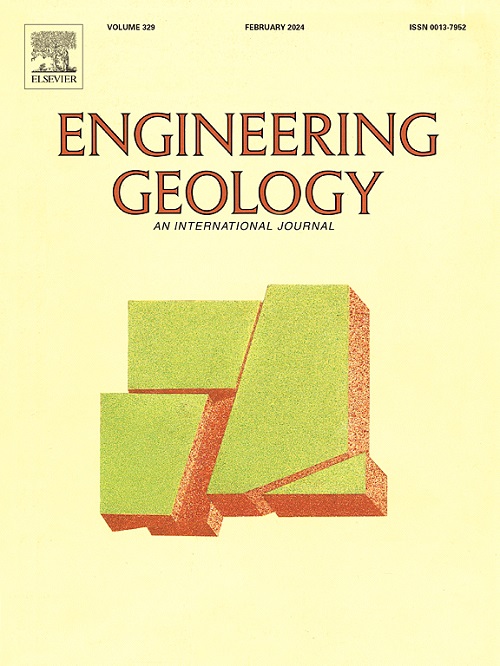裂缝深度对黄土坡古沉积区裂缝诱发滑动的起始和扩展的影响:基于模型试验和激光扫描的三维研究
IF 6.9
1区 工程技术
Q1 ENGINEERING, GEOLOGICAL
引用次数: 0
摘要
在中国黄土高原(CLP),裂缝诱发的古土壤滑动会引发逆坡崩塌,从而影响黄土边坡的长期稳定性。建立裂缝深度与滑动大小之间的定量关系是阐明裂缝诱发的古溶胶滑动逐渐演变的关键,但这方面的研究却很少。在本研究中,我们在一个古溶岩斜坡上进行了模型试验,该斜坡经历了五个干燥-降雨周期。采用三维(3D)激光扫描技术精确量化了裂缝深度和滑动尺寸的变化,并嵌入含水量传感器监测这些裂缝引起的优先流变化。研究结果表明,裂缝深度通过影响裂缝的优先流动能力,在启动和控制古溶胶中裂缝诱导的滑动传播方面起着关键作用。在滑动起始阶段,确定了一个临界裂缝深度,该深度能够通过诱导足够显著的优先流动和大饱和区而触发滑动。根据裂缝对滑动的单一触发效应,发生滑动的深度可以表示为一个取决于裂缝深度的变量。裂缝诱发的滑动一旦开始,先前的滑动事件和当前的裂缝扩展就会通过影响优先流动能力和滑动力值,在尺寸增大和空间位置变化方面加速随后的滑动。考虑到裂缝深度和斜坡坡度在滑动演化的这一阶段对滑动发展的主要影响,我们建立了一个全面的经验公式来描述裂缝引发的滑动深度。我们的研究结果强调了裂缝深度在引发古溶岩渐进裂缝诱导滑动过程中的关键作用,从而为中电站黄土坡上古溶岩地区的土壤保护提供了宝贵的见解。本文章由计算机程序翻译,如有差异,请以英文原文为准。
Effect of crack depth on the initiation and propagation of crack-induced sliding in a paleosol area on a loess slope: Three-dimensional investigation based on model testing and laser scanning
On the Chinese Loess Plateau (CLP), crack-induced sliding in paleosols triggers retrogressive slope collapse, compromising the long-term stability of loess slopes. Establishing a quantitative relationship between crack depth and slide size is key to elucidating the progressive evolution of crack-induced sliding in paleosols; however, research on this topic is scarce. In this study, a model test was conducted on a paleosol slope subjected to five drying–rainfall cycles. Three-dimensional (3D) laser scanning technology was employed to accurately quantify the variations in crack depth and slide size, and water content sensors were embedded to monitor the preferential flow changes induced by these cracks. Results reveal that crack depth plays a pivotal role in initiating and controlling the propagation of crack-induced sliding in paleosols by influencing the preferential flow capacity through cracks. In the slide initiation stage, a critical crack depth capable of triggering sliding by inducing a sufficiently significant preferential flow and large saturation zones was identified. The depth at which sliding occurs can be expressed as a variable dependent on crack depth based on the single triggering effect of cracking on sliding. Once a crack-induced slide is initiated, the combined action of prior sliding events and current crack propagation accelerates the subsequent sliding in terms of increased size and varying spatial locations by influencing the preferential flow capacity and sliding force values. A comprehensive empirical formula was established to characterize the depth of crack-induced slides, considering the dominant influence of crack depth and slope gradient on sliding development at this stage of slide evolution. Our findings emphasize the pivotal role of crack depth in triggering progressive crack-induced sliding in paleosols, thereby providing valuable insights for soil conservation in paleosol areas on loess slopes on the CLP.
求助全文
通过发布文献求助,成功后即可免费获取论文全文。
去求助
来源期刊

Engineering Geology
地学-地球科学综合
CiteScore
13.70
自引率
12.20%
发文量
327
审稿时长
5.6 months
期刊介绍:
Engineering Geology, an international interdisciplinary journal, serves as a bridge between earth sciences and engineering, focusing on geological and geotechnical engineering. It welcomes studies with relevance to engineering, environmental concerns, and safety, catering to engineering geologists with backgrounds in geology or civil/mining engineering. Topics include applied geomorphology, structural geology, geophysics, geochemistry, environmental geology, hydrogeology, land use planning, natural hazards, remote sensing, soil and rock mechanics, and applied geotechnical engineering. The journal provides a platform for research at the intersection of geology and engineering disciplines.
 求助内容:
求助内容: 应助结果提醒方式:
应助结果提醒方式:


